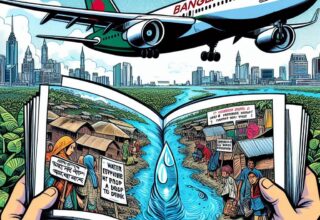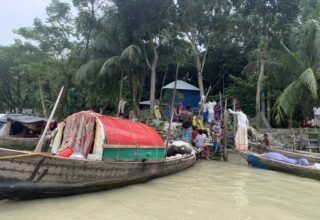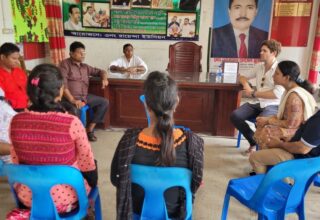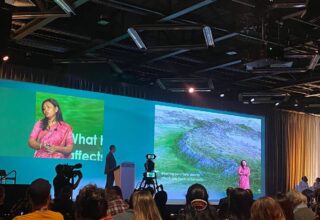Indigenous peoples (IPs) have long been living with nature and observing natural changes whilst sustainably managing and protecting more than 25% of world’s landscape. While IPs constitute only 5% of the world’s population, they contribute to 80% of global biodiversity conservation. However, they are often subjected to systemic racial, socio-economic and legal discrimination resulting in dispossession of their lands and natural resources. A recent estimate by Farrell et al. 2021 showed that indigenous lands in North America have shrunk by 99% due to dispossessions and forced migration. Many IP groups and communities are also disproportionately vulnerable to the impacts of weather and climate related disasters depending on their location. For example, indigenous and local communities in the Himalayas region are exposed to high water flow in the short term, while shrinkage in snow cover is leading to water scarcity in the long term. Multiple indigenous communities such as Afar, Borana and Endorois in the African continent are facing severe and frequent droughts which affect their water and food security. The 2022 Intergovernmental Panel on Climate Change (IPCC) report on Impacts, Adaptation and Vulnerability to climate change asserted that the impacts of climate change on IPs especially severe. This is due to historical, social and institutional exclusion and marginalisation of indigenous and local communities from decision making processes. This often results in the dispossession of lands, forced relocation and violence in their governed territories. The IPCC’s Special Report on Climate Change and Land in 2020 placed emphasis on strong land rights for indigenous communities and local peoples (IPLCs) as a solution to the climate crisis.
A recent project by the International Centre for Climate Change and Development (ICCCAD) and World Wildlife Fund for Nature (WWF) found that many countries acknowledge and have some provisions for IPs rights to their landscapes and territories. However, many nations are yet to recognise the contribution of IPLC’s to climate change mitigation, despite IPLCs preserving about 293,000 million metric tons (Mt) of carbon stored in forestland – representing 33x the estimated global energy emission in 2017 (Frechette et al 2018). IPLCs also use their traditional and local knowledge (TK and LK) and practices to adapt with the changing climate. This includes changes in land management practices, farming and livestock management, house construction and in some cases, weather prediction, as well as migration. For example, IPLCs in Yemen are applying their TK and LK to build heatproof houses using local materials to enhance their resilience to global warming. IPLCs in Pakistan predict weather events using a LK known as “Suri Jagek” (meaning observing the sun) and manage harvesting and livestock farming accordingly to adapt to potential impacts. In addition to such weather prediction systems, many IPs in Africa are also diversifying their livelihood practices, cultivating drought tolerant crops and vegetables and relocating to relatively safer places for adaptation.
While IPLCs contribution to nature conservation, climate change adaptation and mitigation are reported and acknowledged, there are still significant knowledge and evidence gaps for effective application of their techniques and practices. These techniques with TK and LK also require scientific evaluation and could potentially be integrated with state-of-the-art practices and technologies to improve the efficacy of actions to tackle climate change and nature conservation in global landscapes. Moreover, TK and LK are often transferred from generation to generation amongst the IPLCs, placing their knowledge at risk of extinction due to change in lifestyle or location by the youth communities. Recently, the Engineering and Physical Sciences Research Council (EPSRC) of the University of Cambridge provided seed funding to Cambridge Global Challenges (CGC) and ICCCAD to conduct initial fieldwork to capture and understand the vulnerabilities and adaptation of selected IPLCs in Bangladesh, a country well known for its management of climate change.
Primary data collected from the indigenous Garo and Hajong communities in the drought affected northern part of the country, shows that IPLCs are exposed to prolonged droughts and altered rainfall pattern with the late monsoon. Consequently, the water, food, livelihood security and well-being of these communities are affected by climate change, aggravated by reduction in natural forests and limited access to the natural resources. Social and political conflicts exist between the marginal indigenous and predominant non-indigenous communities. These indigenous communities apply their TK to observe changes in natural entities and phenomenon to predicting weather events. Additionally the construction homestead garden and traditional houses aids adaptation to the warming temperature as well as facilitating growth of medicinal plants to support health services. However, these practices are becoming extinct as indigenous communities slowly integrate with the predominant Bengali culture and urban lifestyle. Thus, there is a need to preserve traditional knowledge and techniques not only for adapting to climate change, but also for preservation of nature. Additionally, collating and developing an evidence base of traditional knowledge and practices can offer potential knowledge and technology transfer among climate impacted communities in the global south and north. Successful and effective application as well as avoidance of maladaptation of TK and LK and practices requires rigorous analytical assessments, qualitative and quantitative evaluations. Scope exists to combine traditional knowledge and techniques with contemporary science and technologies where data and big data can play a major role in informed decision making. Finally, countries need to generate proactive plans and policies to acknowledge indigenous people’s contribution to nature conservation and climate change adaptation so humans can strive to live in harmony with nature, both locally and globally, in the age of Anthropocene.
Originally this blog was published on August 08, 2022 on Cambridge Global Challenges project Website.
About the Authors
By Ali Mohammad Rezaie
Prof. Saleemul Huq is the director of the International Centre for Climate Change and Development (ICCCAD) at the Independent University, Bangladesh (IUB).
William J. Sutherland
Alan F. Blackwell







